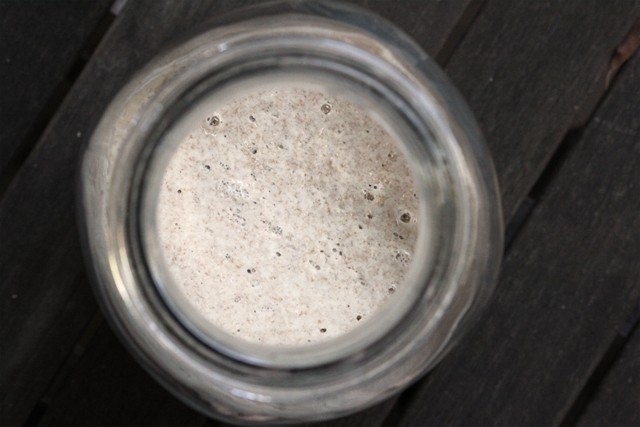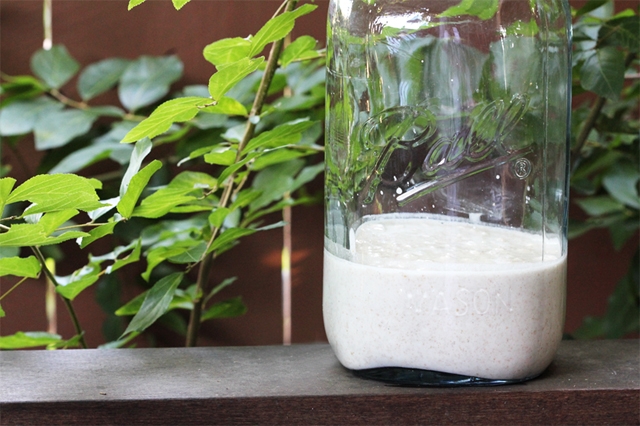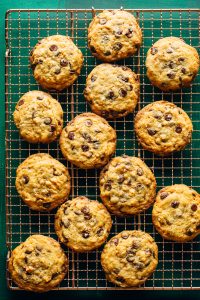
This post may contain affiliate links.
And so continues my Sourdough Starter experiment. If you are just joining in, you can find the previous three days here, here and here. On the evening of Day 3, I noticed that my starter had formed a considerably large amount of hooch. Tangy and yeasty, the hooch actually had quite a nice smell to it, so I didn’t pour any of it off. Instead, I stirred it back into the starter and gave it another feeding. Pictured above is my starter the following morning. Nice and bubbly!
On days 4 and 5 I continued this double feeding regimen to keep my starter happy and well fed. After each feeding, the starter bubbled up then slowly formed a thin layer of sweet yet tangy smelling hooch. Bubbles were usually small and the volume of the starter never increased. These traits are characteristic of a 166% hydration Sourdough starter (see notes below for details). So you might be wondering, if the starter doesn’t increase in volume (a typical indicator of potency), how will I know it is ready for use? Continue reading for my thoughts (and my day 4 and 5 processes).

On the 4th day, give your starter a good stir to redistribute the hooch into the mixture. Feed your starter once in the morning then again in the evening. To feed the starter, discard half of the mixture (or transfer to another jar to start another starter). Then add 1 cup (by volume) all purpose flour and 1 cup (by volume) water, stirring to combine. Leave your jar on the countertop covered in between feedings. Repeat these steps daily until you achieve a vigorous starter.
Notes
- Keeping the starter in a warm area will promote yeast activity. Conversely, cooler temperatures will slow down yeast growth. Try to keep the starter between 65°F to 85°F. When adding water to the starter, be sure it’s room temperature.
- Feeding the starter with different amounts of flour and water (different hydration ratios) will change the result of your finished product. The amount of flour and water suggested above has a 166% hydration ratio (fairly thin). So what does this mean? The starter will produce smaller bubbles and will not rise as much in volume. Also, the starter will have a tangier taste.
- When establishing a new starter, the presence of hooch is not a bad thing. It actually contains a good amount of desirable flavor. With an already established starter, visible hooch can be an indicator that your starter needs to be fed. Keep in mind that if the hooch is ever gray, cloudy and giving off a bad odor, you’ll want to drain it off before stirring.
To see if my starter had reached full potential, I decided to bake a sourdough boule! The results show not nearly enough rise. I will have to say though, the boule had some great flavor! I will continue to nurture my starter over the next several days and report back once I have more conclusive results. Thanks for following along!
146






Amanda says
Looks like it is going really well! As a native Californian, living far away in Tennessee,I have been trying to make a sourdough starter. But mine keeps molding. Do you have any suggestions? Thanks!
Brandon Matzek says
Hi Amanda, when does the mold form? And what method are you using to make the starter?
Amanda @ foodfascinations says
The mold formed after day 2. I’m not sure if it is because I should be feeding it starting from day one, but I was following a recipe from an older edition of The Professional Chef. It says to let it sit for a couple days. I think next time I will try your method.
Kalei says
Hi! So I struggled for months to make a mold free starter, and as it turns out, the brand of flour I was using (war creek eagle mill rye I think) was causing the mold. Once I tried without it, I never got mold again! I now use a mix of King Arthur bread flour and bobs red mill dark rye. Try switching flours!
Mold will also form if there isn’t enough activity, which can result from an underfed starter. I know there’s so much conflicting info out there about when to feed, many sources saying you should only feed when your starter is active and bubbly or has hooch, but I found mine never even got active enough to feed until… well, I fed it more often.
TLDR: try a different brand of flour, and feed consistently/often. Hope this helps!
Ann P says
MMmm Your boule actually looks quite yummy, despite what you said about the low rise! I was thinking the “discards” or the “second starters” would be great to give to friends so they could have some sourdough, too!
Eliot says
I have been tempted lately to give this a go. I remember my mom using something she called sour dough starter as a kid, but I don’t really think it was the true sour dough. I remember it as being a sickly sweet dough starter. You are making this look too easy.
Edmund says
A regimen is a prescribed treatment schedule or an exercise routine. A regiment is a unit of troop organization in the military.
Brandon Matzek says
Fixed!! Thanks for the suggestion.
LL says
Quarantine time…tempted to make sourdough starter and found this website, how’s the starter now? (I know it’s been 8 some years…wow time flies)
Brandon Matzek says
Hey LL, so my homemade starter eventually fizzled out. I think it was an issue with my tap water. I have heard that some people do have success following the steps outlined in this series. To be honest, I eventually purchased a started on Amazon from a company called Breadtopia, and it’s been fantastic. I’d highly recommend buying a starter or getting some discard from a friend. You’ll save yourself a lot of time, effort and flour!
LL says
Thank you! I’ll definitely check them out! Stay safe!!!
Donna says
I started my starter from scratch a week ago, following a recipe I found.i take out a cup of starter, stir the hooch back in and add 1/2 cup water and 3/4 cup flour. I now do this once a day. I have small bubbles on top, but the starter seems to loose. Should I add more flour..? How do I know when the starter is ready to use? Should it be thick like a dough in the jar? I have never done this before so I appreciate any help!
Brandon Matzek says
Hi Donna! You’ll know your starter is ready to use when it is rising consistently each day. When you feed a healthy starter, it will bubble and grow to a certain point, and then collapse. Once the starter collapses, you can feed it again. So, if your starter is not bubbling a lot and rising, it’s not ready.
Since posting this process, I’ve switched from measuring in cups to grams, and I also transfer my starter to a clean jar. So maybe try this: Give the starter a stir, then measure out 50 grams of the starter to a clean jar. Add 100 grams water and 100 grams flour, mixing to combine. Once your starter is really active, you may want to do this twice a day. Two things to consider: rye flour and whole wheat flour can help jumpstart a starter, so if you’ve got them, feed with 50 grams rye flour + 50 grams AP flour instead. Also, tap water can have a negative effect on a starter, so you may want to use filtered if possible.
Finally, like I mentioned in a comment above, I didn’t have much success with making my own starter from scratch. It’s a lot of effort and wastes a lot of flour (a precious commodity right now!). If you can, I would recommend purchasing a starter online to save yourself some time and money. I got one for like $8 a couple years ago (from Breadtopia). It’s strong, resilient and has made plenty of gorgeous loaves of bread. Good luck!!
Florence Milone says
once I purchase the starter on line as you suggested, how often can I feed it and what would be the amount of water and flour to add to the starter. I need your help. Thank you.
Brandon Matzek says
Hi Florence! So glad you got a good starter online. Your sourdough starter feeding schedule will depend on how often you use it. If you are baking bread regularly, you’ll want to feed it daily. If you are baking bread infrequently, then I’d recommend you store the start in the fridge and feed it once a week.
To feed your starter, transfer 4 ounces of the old starter into a clean jar and add 4 ounces of filtered water and 4 ounces of flour, stirring to combine. Now your start is considered to be fed!
You should discard the remaining old starter or you can give some to friends or you can use it in other recipes (sourdough waffles, pancakes, muffins, crackers, etc.).
I hope this helps and let me know if you’ve got other questions!
Penny says
New starter here..day one and two, it rose a lot, bubbled a lot, I am using 2:1 white and wheat flour, I mix ahead of time and store in cabinet, my feeding is 1:3:3 (one part starter to 3 parts flour snd 3 parts water) using boiled, then cooled tap water, I store in a sealed jar..I’m on day five, color is good, rise is nominal, bubbles okay..smells umm..tangy I guess, I change to clean jar each feeding 7am and 7pm..with not much volume change, but some bubbles, is this ok or should I change something, keeping in oven with light on for warmth..my home is 67°F. Oven is cozy..just put a thermometer in oven to see what temp my light on is keeping the enviroment. Using Mason jars with just lid,,no rings.